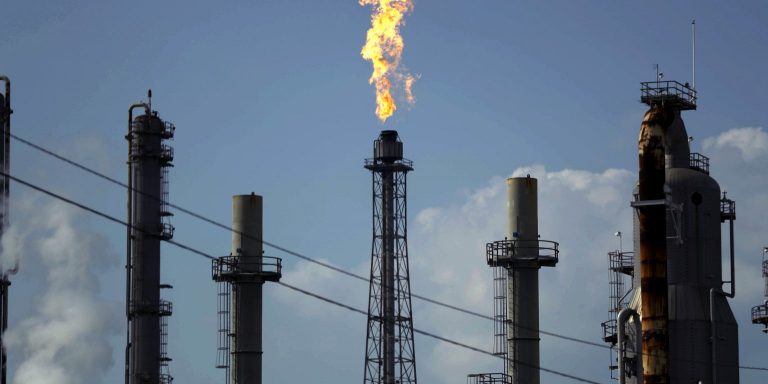INTELBRIEF
July 30, 2020
IntelBrief: The Impact of Energy Price Fluctuations on Geopolitics in the Middle East

Bottom Line Up Front
- The recent dip in the price of oil might have given the world a glimpse into the geopolitical future of the Middle East.
- The Russo-Saudi oil price war highlighted fissures in the global oil market and the geopolitical balance of the Middle East, while demonstrating how reliant Saudi Arabia’s economy is on the global market for oil.
- While initially effective, Iran’s efforts to reduce budgetary reliance on petroleum products are unsustainable and Iranian government officials have started to look eastward for assistance, a trend likely to continue.
- U.S. retrenchment from the Middle East and abandonment of the Carter doctrine, along with growing Russian and Chinese influence in the region, leaves Riyadh extremely vulnerable to any reductions in revenue.
The recent dip in the price of oil might have given the world a glimpse into the geopolitical future of the Middle East. The compounded effects of a Russo-Saudi price war and the COVID-19 pandemic resulted in the Brent crude oil benchmark plunging to around $19 / a barrel. For countries with budgets depending on oil hovering around $50 / a barrel, this presents a significant problem – one which will not be going away any time soon. The price war between Saudi Arabia and Russia may have reached its logical endgame, but the effects of the coronavirus pandemic on travel and business continue to linger and might do so until an effective vaccine is reliably developed. Economists and policymakers in both Saudi Arabia and Iran—two regional powers historically dependent on the production and export of oil products—have been reckoning with the reality of a world transitioning away from hydrocarbons for some time now. But this shock to the system could mean that they have even less time to develop solutions than previously projected.
In early March of 2020, disagreement between officials in Moscow and Riyadh over petroleum production cuts in the wake of a coronavirus-induced reduction in demand, combined with Saudi suspicion of Russian adherence to existing OPEC+ production cuts, led to a standoff between Russian and Saudi oil producers. Though the dispute was eventually resolved when Russia, much to its dismay, agreed to drastically cut oil production to a level at par with the Saudis (an agreement one Russian oil executive compared to the Brest-Litovsk treaty between Nazi Germany and the Soviet Union), the Brent benchmark has yet to return to pre-dispute levels. This incident highlights emerging fissures in both the global oil market and the delicate geopolitical balance of the Middle East. Saudi Arabia, the world’s largest exporter of petroleum, has an economy that is incredibly reliant on the global market for oil, as 50% of the country’s GDP comes from oil-based revenue. Though Crown Prince Mohammad bin Salman’s bold Vision 2030 plan aims to drive the country away from hydrocarbon dependence, the window for this transition to take place might be smaller than anticipated.
In the case of Iran, the recent volatility of the oil market is part of a string of financial and political developments that have afflicted the country’s economy, notably since the beginning of the Trump administration. The administration’s withdrawal from the Obama-era nuclear deal and its subsequent policy of heavy economic sanctions on Iran have placed an extreme strain on the Iranian oil industry. These sanctions have forced Iranian policymakers to get creative. A wave of reforms, including raising taxes and privatizing government-owned holdings, has significantly reduced Iran’s budgetary reliance on oil to 17% of its GDP in 2018. Iranian officials plan to eliminate dependence on oil-based revenues by 2024. This plan, though wildly ambitious, might be necessary. As a result of sanctions, Iranian oil producers must sell their product at a price almost $10 below the benchmark (to make it worthwhile for purchasers to violate the sanctions), and the Iranian budget for 2020 was outlined assuming a price of $50 per barrel. Though sweeping and initially effective, the efforts made to reduce budgetary reliance on petroleum products cannot sustain this level of strain and Iranian government officials have started to look eastward for assistance, a trend likely to continue.
Layered on top of the economic impact of fluctuating oil revenues is a vast web of competing geopolitical interests. In the wake of the U.S. drawdown in Syria and Washington’s changing attitude toward engagement in the region, Russia has devoted resources to reestablishing itself as a regional powerbroker and supported the government of Bashar al-Assad throughout the Syrian civil war. Putin will likely craft his regional policy toward the Saudis through the lens of his unfortunate draw in the price war. China and Iran are in the process of finalizing a massive economic and security arrangement that is designed to provide China unprecedented access to the Persian Gulf and Iranian oil reserves, in exchange for the foreign investment and economic relief that Iran so desperately needs. These factors, coupled with the impending accession of the impetuous Saudi Crown Prince, mean that any escalation between Saudi Arabia and Iran will not result as favorably for the Saudis as it would have five years ago. U.S. retrenchment from the Middle East and abandonment of the Carter doctrine, compounded with expanding Russian and Chinese influence in neighboring countries, leave the Saudi state increasingly vulnerable to any reductions in revenue, making the Vision 2030 plan more important than ever to implement, although the Kingdom is already encountering serious challenges. The new tripartite regional alignment will force policymakers in Washington, Riyadh, and elsewhere to reconsider their understanding of regional power dynamics and ready themselves for new, emboldened actors to assert their influence.
.
For tailored research and analysis, please contact: info@thesoufancenter.org